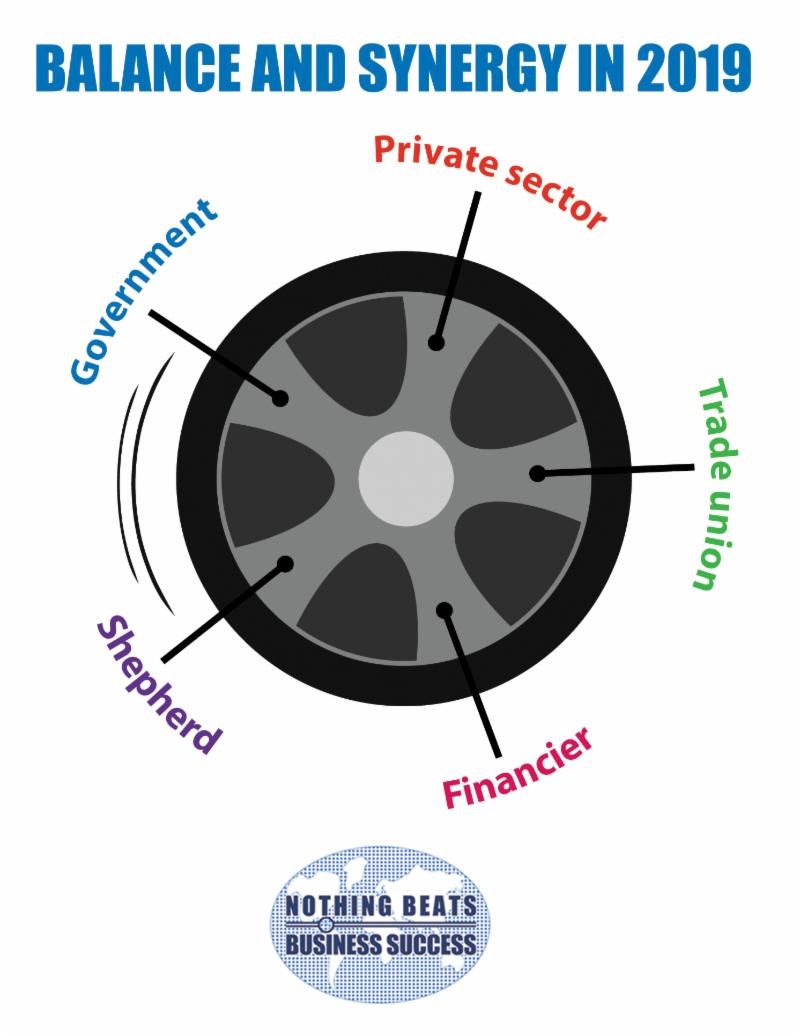“And we know that for those who love God all things work together for good, for those who are called according to His purpose.” – Romans 8:28
Balance may be defined as a state of equilibrium in a partnership. If the wheels of business, economic growth and sustainability are to experience a smooth ride, the partners in the process – government, the private sector, trade unions, shepherds and financiers – must be in balance.
The role of government is to make the laws and spend the taxes; the role of the private sector is to grow the economy; the role of the trade unions is to explore the opportunity to shift their collective bargaining thrust to one where they encourage increases in productivity for fair compensation; the role of shepherds is to creatively transfer knowledge and experience directly to entrepreneurs; and the roles of financiers include the provision of soft stabilization loans and investment to grow the economy.
Synergy may be defined as the working together of two things to produce an effect greater than the sum of their individual effects. In business, synergy is an important catalyst to stimulate an efficiency trend. It induces an increase in efficiency among partners. As efficiency increases, profitability increases; as profitability increases, economic growth increases and this may ultimately lead to sustainability and happiness.
Each of these partner roles is important, in and of itself, but when they work together their combined effect is much greater than the sum of their individual effects. There are five partners, therefore 10 combinations of two partners each. If we develop the synergies associated with each of these 10 combinations, there is a cumulative explosive potential for an increase in efficiency.
Here is a guide as to how this system may work: (1) The partnership of government and the private sector should create an enabling environment to facilitate private sector growth. For example, support enterprise development. (2) The partnership of government and the trade unions should increase productivity in the civil service. For example, agree on the optimal size of the civil service. (3) The partnership of government and the shepherds should formally accredit suitable persons as shepherds. For example, training of shepherds programme. (4) The partnership of the government and the financier must secure local and international restructuring and investment funds. For example, securing IMF funds and mobilizing local and international private sector funds.
(5) The partnership of the private sector and the trade unions should increase productivity in the private sector. For example, enhance labour, technology and process productivity. (6) The partnership of the private sector and the shepherds should result in expert leadership in the management of businesses. For example, introduce the management of business systems (ManOBiz) matrix as a shepherding tool. (7) The partnership of the private sector and the investor should create an innovative financing model. For example, create a quick response seed/equity capital fund. (8) The partnership of the trade unions and the shepherds should focus on productivity. For example, introduce trade unions to formal productivity enhancement measures. (9) The partnership of the trade unions and the investor to provide security for the investment. For example, convince the investor of the importance of trade union practices. (10) The partnership of the shepherds and the investor should inculcate the concept of security of the investment. For example, “shepherding as collateral”.

As we make a valiant attempt to grow our economies in 2019, the concepts of balance and synergy are paramount. Happy New Year!
